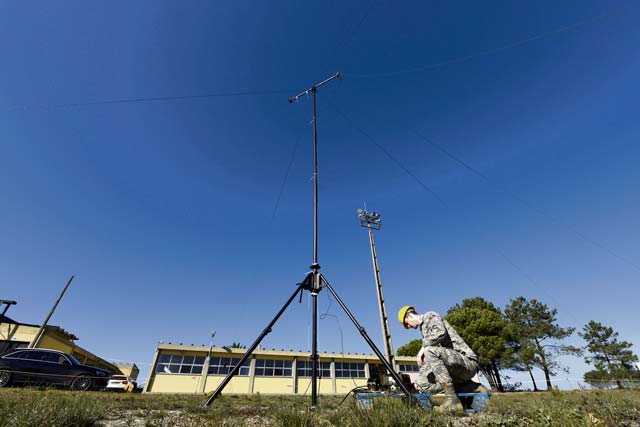
Ramstein Air Base is the home of numerous units that have unique missions, and one of the most unique is the 1st Combat Communications Squadron. Tasked with bringing the tactical edge of cyberspace to deployed and hostile environments, 1st CBCS provides deployed communications, from satellite dishes to mobile air traffic control towers, to the U.S. military in the European and African theater of operations.
In February the 1st CBCS deployed a team of Total Force members to the Portuguese air force base Aérea 5 in Monte Real, Portugal. At the mission site, 1st CBCS provided communications to the 480th Fighter Squadron from Spangdahlem Air Base as the unit flew exercise sorties for their F-16C Fighting Falcons with the Portuguese air force.
One of the key training objectives for the CBCS team deployed to Portugal was to prove that high frequency radios are still a viable option when the U.S. military is fighting in an environment where other standard means of communications are compromised. Using HF radios is not a new technology; the world has been using high frequency radios to talk since the late 19th century and HF is still popular with amateur radio enthusiasts. The resiliency of HF signals make it an ideal means of communication due to its ability to broadcast over long distances with minimal interference.
After coordinating with the Portuguese to find space on the air base, a team of four CBCS Airmen erected an antenna mast standing over 50 feet tall connected to their radio equipment in an adjacent building. Working with a team over 1,400 miles away back at Ramstein, the two sites were able to communicate via text chat and voice. Additionally, the sites were able to send data files to each other in seconds, a first for the squadron that normally uses complicated tactical networks to share files.
This past week, 1st CBCS took it a step further; using the same HF radios, they were able to communicate across the Atlantic back to an HF radio site in Maryland. To accomplish this their team worked with the Army Signal Corps and employed radio relay stations to reach back to the East Coast, pushing the envelope for the reach of tactical comms and strengthening joint interoperability.
While there is still work to be done to refine its effectiveness, this capability is a huge success for the communications community. This team is achieving one of the Secretary of the Air Force’s priorities of driving innovation by leveraging old technology and bringing it into the 21st century. Technology like HF allows our warfighters to maintain command and control options in contested environments.
To face the challenges of modern adversaries and rapidly evolving battlefields, Airmen of the 1st CBCS will continue to modify and develop new tactics, and look to the past for ideas that help bridge the gap between experience and operational
capabilities.







